COMMENTS ON THE ART MARKET
Valentine's Day Sale
Love is in the air.
To celebrate, we are offering a 15% discount on all items in our gift shop:
Use this code at checkout: LOVE2023
This sale will run through January 14th.
Remember to use the code LOVE2023 at checkout.
____________________
Gallery News
20 West 55th – Moving Along

The family stopped by our new space to see how the build-out was moving along and were pleased to see that they had installed the sheetrock in most areas. The crew has also begun the taping and spackling process. In the photos below, you will note one ‘gallery space’ has no sheetrock. That space will display our historical works of art, and the walls will be closed with plywood and covered with a dark blue fabric, crown and base molding, etc. During our meeting with the contractor, he finally had the price for the wall covering; it was lower than expected – nice! Then we were given the complete update.
All the electrical, fire alarm, and plumbing roughing were complete, and they are still working on the lighting controls, sprinkler, and mechanical roughing. The installation of the bathrooms has begun (they were putting in the wall tile while we were there). All the lighting fixtures are at the supplier’s warehouse, but the lighting controls have yet to arrive. The millwork (painting storage area) is in production, and the doors, hardware, appliances, and flooring are on order.
Now for the items that could, at some point, prevent the process from moving along. The HVAC unit is estimated to arrive at the end of February, and there was no estimated time for the doors. It is crazy to think that it can take months to get doors (no doors, no usable space). They are now estimating that the gallery should be ready by mid-March. We hope to have more information during our next visit, which will happen in about ten days.
If you want to see how far we have come, here are links to the blog posts we made on December 16 and August 12 (the latter is when the process started).
We Are Even Closer Now!
 The construction of our new gallery at 20 West 55th Street is moving along. The duct insulation has been completed, and the inspection will occur next week; after that, they will begin framing and closing the ceilings. The bathroom floor tiles were installed, and they are preparing/leveling the floors to install carpeting and tiles. The storage and historical gallery plywood wall installation has also begun. We were very pleased to learn that the installer could use 4 x 10-foot pieces, which eliminates the possibility of horizontal seams showing through the wall covering.
The construction of our new gallery at 20 West 55th Street is moving along. The duct insulation has been completed, and the inspection will occur next week; after that, they will begin framing and closing the ceilings. The bathroom floor tiles were installed, and they are preparing/leveling the floors to install carpeting and tiles. The storage and historical gallery plywood wall installation has also begun. We were very pleased to learn that the installer could use 4 x 10-foot pieces, which eliminates the possibility of horizontal seams showing through the wall covering.
The pantry and bathroom fixture work should begin by the end of this month. After that, the crew will start painting the open ceilings and walls. Hopefully, the appliances will arrive by the first week of February, and then they will move on to the lighting fixtures and controls. By the middle of the month, the building of the storage room will commence, and if all goes well, the mechanical unit and doors will arrive by the end of February.
The final steps will be completing the security system and the arrival of our office furniture, which may take a few extra weeks. We may have to start with some folding tables and chairs, but we are excited to see the completed project and can't wait to move into our new space.
Upcoming Shows

Palm Beach – We Are Coming Back!
For the 18th year, we will be participating in The Palm Beach Show that runs from February 16 – 21, 2023.
Rehs Galleries will be exhibiting a wide selection of important historical works by Bernard Buffet, Eugene Boudin, Daniel Ridgway Knight, Frederick Morgan, Gustave Cariot, Montague Dawson, John F. Herring, Charles Frere, a fabulous group of paintings by Edouard Cortes, and many others.
Rehs Contemporary will showcase works by many of the artists we represent. Among them will be notable paintings by John Stobart, Ben Bauer, Todd Casey, Kari Tirrell, Josh Tiessen, Erik Koeppel, Ken Salaz, Mitsuru Watanabe, Hiroshi Furuyoshi, Lucia Heffernan, Natalie Featherston, Mark Daly, and Julie Bell.
If you are interested in attending, please let us know as soon as possible. We have a limited number of complimentary tickets for both evening openings (5 PM and 7 PM), and general admission.
Opening Night
February 16
VIP Preview - 5:00 pm
Collectors Preview - 7:00 pm
General Show
February 17 - 21 - 11:00 am - 6:00 pm
Please be sure to specify the type you would like - Opening Night (and time) or General Admission. Remember, our supply of complimentary tickets is limited, but we will do our best to accommodate everyone.
____________________
Stocks & Crypto
By: Lance
By all accounts, the stock market is embracing the "New Year, New Me" mentality… I'm not sure I can explain it, but I'm certainly not complaining. It seems everything is trending in the right direction – the Dow is up almost 3% in January, the S&P 500 has gained more than 6%, and the NASDAQ has popped more than 10%! Not only that, but some of last year's worst performers are ranking among the best in 2023. Warner Bros. Discovery (WBD) fell off a cliff last year, shedding nearly 60%... it has surged more than 50% in the last 30 days. And they're not alone… Paramount has jumped 35%, Disney is up about 25%, and Netflix has gained more than 20%.
Investors are anxiously awaiting the Fed's upcoming announcement on interest rates – while an interest rate hike is all but certain, it may be a smaller increase with waning inflation concerns. Further, there is a growing sense that the economy may avoid a recession, which could allow the Fed to pause rate hikes later this year… I know, I know, wishful thinking. I'm sure we'll have some sense of how things will be moving by the end of the week, especially as some major companies are set to announce earnings – those include Meta, Apple, Amazon, and Google. Then again, we could just be setting ourselves up for an even more dramatic drop with increased volatility – who knows, I certainly don't… and if I did, I'd be charging you to read this!
Looking at currencies and commodities… the Pound and Euro both gained about 2% relative to the US Dollar, crude dipped about 2%, and gold jumped more than 5%. Perhaps the biggest shock of all is that crypto is on fire again… Bitcoin gained about 40% in January, while Ethereum and Litecoin are up 32% and 37%, respectively. That's probably good news for all those NFTs, but I'd still recommend staying away for now.
Frankly, my relatively uninformed opinion is that this is just part of the market's current instability and this run will be short-lived… it's important to keep in mind that volatility doesn't just mean that things can decline quickly, but that there can be rapid, unpredictable changes in either direction. That said, hopefully the ride this year isn't too bumpy.
____________________
The Dark Side
By: Nathan
Requisitioned Rubens
 A painting by Peter Paul Reubens in relatively good condition is by no means worthless. Yet the owners of one of his religious scenes are currently under investigation for trying to milk a bit more cash out of it. On December 30th, the painting The Resurrected Christ Appears to his Mother was confiscated by Italy’s Carabinieri to investigate a smuggling and money laundering scheme meant to increase the work's value.
A painting by Peter Paul Reubens in relatively good condition is by no means worthless. Yet the owners of one of his religious scenes are currently under investigation for trying to milk a bit more cash out of it. On December 30th, the painting The Resurrected Christ Appears to his Mother was confiscated by Italy’s Carabinieri to investigate a smuggling and money laundering scheme meant to increase the work's value.
Resurrected Christ has been hanging at the Palazzo Ducale in Genoa since early October 2022 as part of a Rubens exhibition. Rubens published a book of sketches of Genoa’s palaces in 1622, so staging this exhibition in one of these palaces was rather appropriate. The painting is currently attributed to Rubens and his workshop, but some disagree with this assessment. Some art historians doubt whether the work was created by Rubens since little documentary evidence attests to this attribution. Resurrected Christ, currently insured for €4 million (or $4.27 million), was previously owned by the Cambiaso family, a prominent family from Genoa who once occupied the palace where the Rubens exhibition is being staged. The family sold it to the current owners in 2012 for €300K. The new owners’ shady dealings started not long after, when, in 2014, they exported the work to Prague, claiming it was by an unknown Flemish artist and only worth €25K. Later on, the owners allegedly founded several companies abroad to pass the Rubens back and forth, orchestrating fake sales to artificially increase the painting’s value.
Only a few days after the Carabinieri seized the painting, it was returned to the Palazzo Ducale, and will remain there until the Rubens exhibition ends on February 5th. It is likely that the painting may be seized again sometime in the future as part of the investigation, but currently, its future remains uncertain.
Spaniard’s Forgeries Finally Seized
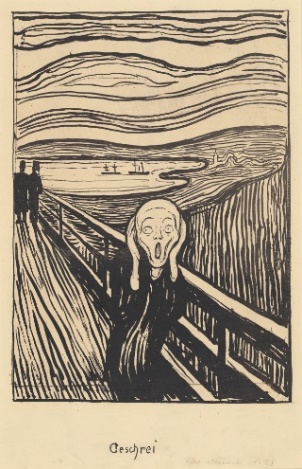
Whenever I’ve written about forgers getting caught, it’s nearly always been about ambitious people trying to pass something off as a long-lost masterwork. Typically it’s by one of the great Old Masters or Impressionist giants that might sell for millions when gone undetected. However, that doesn’t mean that the small-time forgeries can’t make the news or grab the attention of the authorities. A 67-year-old man in Spain found that out the hard way.
In 2019, an Austrian collector Tomas Weber bought a lithograph by the Spanish Basque artist Eduardo Chillida from the Munich-based auction house Hampel. While Chillida is primarily known as an abstract and surrealist sculptor, he has some works on paper available on the market. The most expensive Chillida print ever sold was a woodcut auctioned off at the Munich auction house Ketterer for €37K hammer (or $48.9K). On the other hand, Weber paid €3.9K for the work but soon suspected it was a forgery. Weber discovered that a Spanish man named Guillermo Chamorro had consigned the work. Originally, Weber just wanted a refund for the forgery, but after some digging, the Austrian collector found some other fake Chillida works at other auction houses. The Madrid-based Setdart auction house had several of them in their possession, all of which Chamorro had consigned. Weber passed this information off to Spanish police, leading to the discovery of at least 15 forgeries created by Chamorro.
Chamorro is now charged with intellectual property theft and fraud. Spanish authorities have since confiscated 10 of the 15 fake works. The other five, previously attributed to José Guerrero and Saul Steinberg, were sold in December 2018 and have not been recovered. Among the confiscated forgeries were several prints that were previously attributed to Edvard Munch as iterations of his famous Scream. José Manuel Lara, an expert from the Reina Sofía Museum in Madrid, helped in confirming the Munch prints as fakes by pointing out that they had been made using a modern inkjet printer. Spanish prosecutors are now arguing for a six-and-a-half-year sentence for Chamorro.
____________________
Really?
By: Amy
Mystery Surrounds Indian Princess Coin
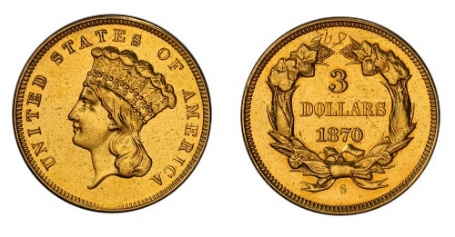 In 2000, the American Numismatic Association's Edward C. Rochette Money Museum was thrilled to have been selected as the ideal new home for the Harry W. Bass Jr. coin collection. Located in the historic Colorado Springs City Hall building, it houses a collection of coins, paper money, tokens, medals, and other numismatic items from around the world. The collection includes currency from ancient Greece and Rome, medieval Europe, and the United States.
In 2000, the American Numismatic Association's Edward C. Rochette Money Museum was thrilled to have been selected as the ideal new home for the Harry W. Bass Jr. coin collection. Located in the historic Colorado Springs City Hall building, it houses a collection of coins, paper money, tokens, medals, and other numismatic items from around the world. The collection includes currency from ancient Greece and Rome, medieval Europe, and the United States.
After more than twenty years as the museum's centerpiece, in 2022, the Harry W. Bass Jr. Research Foundation's executive board decided to sell the collection. The proceeds would go to support their mission of helping non-profit organizations in youth and education with a focus on early childhood literacy.
Harry W. Bass Jr. (1920 – 1998) amassed one of the world's finest coin collections over his lifetime. The collection included examples of many rare and historically important American coins and paper currency. Among the items was a complete set of $3 gold pieces. One of the rarest coins from the group is an 1870-S $3 gold Indian Princess coin which happens to be surrounded by a bit of mystery.
The mystery revolves around the San Francisco Mint's granite cornerstone, where the legendary 1870-S is said to have been placed. According to the San Francisco mint records, only one 1870-S $3 gold Indian Princess coin was struck and encased in the cornerstone. On May 25, 1870, a ceremony was held to lay the symbolic cornerstone of the new building's foundation. While newspapers covered the event and reported that the cornerstone was placed on the northeast side of the building, the actual cornerstone has never been located. Could it have been removed at some point?
Many have questioned whether the earthquake of 1906 may have damaged the building enabling someone to remove the precious coin. But news reports at the time stated that the building survived virtually undamaged. The foresight of architects at the time was to design the building so it would float on the foundation in case of an earthquake; their prudence paid off. It is, therefore, unlikely that the cornerstone was damaged.
The following year, in 1907, an 1870-S $3 coin appeared on the market; William Woodin purchased it and sold it in 1911. Since then, it has been bought and sold to several private collectors, the last being Harry Bass, who acquired it at the historic Eliasberg Sale in 1982 for $687,500.
Was this the coin that was once housed in the cornerstone? Or was there a second coin secretly struck? Only the San Francisco Mint Coiner J.B. Harmstead would know, and he can no longer answer that question.
In any event, 'an' 1870-S $3 gold coin was the top lot at the sale last week. It was estimated to bring $5M and just rolled by the expectation when including the premium; it hammered down at $4.6M ($5.52 w/p).
The Bass coin collection, consisting of nearly 210 pieces, was valued at as much as $60M and sold over two auctions. Part I was sold in September 2022 and brought in $20.5 M, while Part II garnered just over $24M. That adds up to slightly over $44.5M, and while it was short of expectations, it will greatly help dozens of Dallas-based non-profits that the Harry W. Bass Research Foundation supports.
King Charles II Coronation Mug
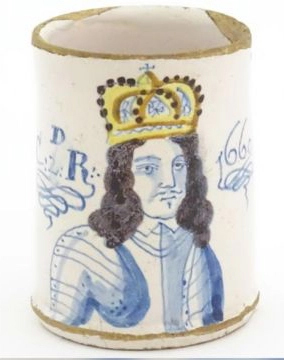 As you wander around a flea market, would you consider buying a chipped and heavily distressed-looking mug for just £2 ($2.50)? Well, one sharp-eyed couple did that, and their meager investment paid off – big time! At a market in England, a couple spotted a mug with an image of King Charles II and a date of 1660; they quickly snapped up the 362-year-old piece.
As you wander around a flea market, would you consider buying a chipped and heavily distressed-looking mug for just £2 ($2.50)? Well, one sharp-eyed couple did that, and their meager investment paid off – big time! At a market in England, a couple spotted a mug with an image of King Charles II and a date of 1660; they quickly snapped up the 362-year-old piece.
King Charles II is pictured on the mug wearing a new state crown. After the execution of his father, Charles I, Oliver Cromwell ordered the destruction of the crown jewels. The crown jewels were sold off and melted down, with the proceeds going to the government. Cromwell believed the jewels represented the monarchy's unjust privileges and wanted to end them.
Cromwell, an English military and political leader was best known for leading the Parliamentarian victory in the English Civil War (1642–1651) and for being Lord Protector of England, Scotland, and Ireland from 1653 until he died in 1658. He is one of the most controversial figures in British history and is widely considered one of the greatest military and political leaders of all time. His son, Richard Cromwell, was his successor.
King Charles II regained the throne in 1660 following the Restoration of the Monarchy; his coronation was on 23 April 1661, in a lavish ceremony at Westminster Abbey. This was only after a political agreement between Parliament and the army, who had supported the execution of his father ten years earlier. This agreement was known as the "Agreement of the People." It granted Charles II some concessions, including the right to a limited monarchy, religious toleration, and a promise of no retribution against those involved in the execution. During his reign, Charles II oversaw the passage of the Habeas Corpus Act, the Exclusion Crisis, the Glorious Revolution, and the English Bill of Rights.
The couple decided to have the mug tested for dating purposes, but the test results were inconclusive. They decided to auction it off anyway and were happy to receive a £1-2000 estimate. Two phone bidders were determined to own the mug, and when the hammer finally fell, someone paid £12,000! (£14,000 w/p). According to experts, had the couple been able to obtain the provenance or conclusive dating results, the mug might have fetched closer to £70K! So, here's a thought, as we all await the coronation of King Charles III, if there is a souvenir mug, snatch it up so one of your descendants can make a few extra bucks one day!
____________________
Architecture In Art
By: Lance
Architecture In Art - Bleed II By David Pollot, Featuring Times Square
I’m bending the rules for this week’s Architecture in Art. We’re not checking out a building per se, but more so exploring one of the most famous spaces in the city and the world – Times Square. While every real New Yorker dreads this area, it is truly the heart of NYC. In fact, it’s the second most visited location in the world, only behind the Las Vegas Strip!
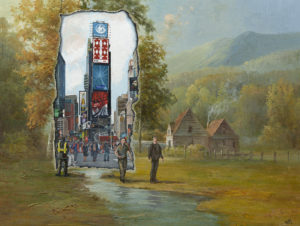 Dave Pollot’s work Bleed II captures a current glimpse of Time Square, along with what it looked like in a not-so-distant past. Times Square has only existed for a bit over a century… and the notion we have of Times Square today is an even newer concept.
Dave Pollot’s work Bleed II captures a current glimpse of Time Square, along with what it looked like in a not-so-distant past. Times Square has only existed for a bit over a century… and the notion we have of Times Square today is an even newer concept.
Back in the 1700s, this land was filled with nature and had small streams running through it. It belonged to a general of the New York militia who served under George Washington who used it for farming and breeding horses. By the 19th century, it had been acquired by John Jacob Astor. While the Astor name is held in high regard, it might surprise you to know he made his fortune by establishing a monopoly on the fur trade and then getting wrapped up in smuggling opium; he used the proceeds to invest in NYC real estate. Astor made his second fortune selling off his land to hotels and developers as the city grew.
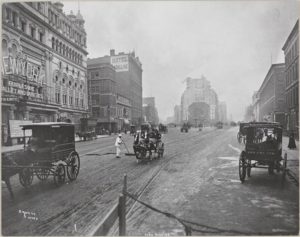 By the end of the 1800s, the area was known as Longacre Square. It was in December of 1880 that Broadway became electrified; the bright lights attracted large, wealthy crowds. But it was also around this time that it was given the nickname Thieves Lair. While theatres began dominating the area, underground businesses like gambling and prostitution followed, and the wealthy theatre patrons made for easy pickpocketing targets.
By the end of the 1800s, the area was known as Longacre Square. It was in December of 1880 that Broadway became electrified; the bright lights attracted large, wealthy crowds. But it was also around this time that it was given the nickname Thieves Lair. While theatres began dominating the area, underground businesses like gambling and prostitution followed, and the wealthy theatre patrons made for easy pickpocketing targets.
It wouldn’t be until 1904 that the name was officially changed to Times Square, in honor of The New York Times; they had moved their headquarters to the south side of the main intersection. That same year, electrified advertisements began popping up – the first included Trimble Whiskey and Budweiser. Following WWI, it became a cultural hub as theatres continued to pile in, along with music halls and upscale hotels. That’s when advertising took over with some of the largest billboards in the world.
Through the Great Depression, many theaters closed and were replaced with brothels and saloons; the area had a seedy reputation for decades. By the 60s, it was described as “the worst block in town” – it was filled with sex shops and peep shows, and crime became rampant. To make matters worse, the NYPD was ordered to stay away from the area to avoid corruption scandals that plagued the department at the time.
It wasn’t until the 90s that Times Square was revitalized into what we think of today. Now, it’s one of the world’s most popular tourist destinations, with approximately 50 million visitors annually, and home to the iconic New Year’s Eve Ball Drop.
____________________
The Art Market
By: Nathan
Jane Fonda At Christie's

Next week, on January 18th, Christie’s New York will be hosting its sale of Outsider and Vernacular art. The hundred or so lots available are from self-taught artists or those working in naïve or primitive styles, including James Castle, Nellie Mae Rowe, and Bill Traylor. However, some observers have focused on this sale for a different reason. While a good portion of the lots come from the collections of botanist Siri von Reis and Philadelphia lawyer Jack Bershad, a total of fourteen lots come from the collection of actress Jane Fonda. The Dial family created all the pieces offered from Fonda’s collection, a family of outsider artists based in Alabama that includes Thornton Dial, his half-brother Arthur Dial, and his son Thornton Dial, Jr.
In 1981, Thornton Dial lost his job when the local factory that made Pullman railcars closed, allowing him to pursue art full-time. Only a few years later, he met Atlanta art dealer Bill Arnett, and his work became popular among some collectors. His work is now on display at the Brooklyn Museum of Art, the Whitney Museum, Atlanta’s High Museum, the Smithsonian American Art Museum, and, since 2014, the Metropolitan Museum of Art. Since the 1990s, Jane Fonda has been collecting outsider and vernacular art after Arnett introduced her to Dial’s paintings. In an interview, Fonda stated she was first drawn to Dial's work because of “the dynamism, the energy, the courage, [and] the rawness". Since then, Fonda has worked with Arnett to promote the works of Black artists in the southern United States through several projects and initiatives. Dial’s most valuable work sold at auction to date came courtesy of Fonda’s collection when his 1999 painting Trophies (Doll Factory) sold at Christie’s London in October 2019 for £225K w/p (or $277.6K). Two of Dial’s untitled works are expected to make the top three lots at the Christie’s sale, with both expected to sell between $50K and $100K. Whether the specialists considered Fonda’s fame when assigning these estimate ranges is unknown, but I suppose everyone will see once the auction commences next Wednesday afternoon.
Sotheby's New York - Art Of The Americas
 On Wednesday, January 18th, after a weeks-long lull in auctions to accommodate the holidays, Sotheby’s New York hosted its Art of the Americas sale. The auction mainly featured nineteenth- and early twentieth-century paintings. In the end, all of the top lots were contained to the first ten pieces sold. The White-Headed Eagle by John James Audubon hit its high estimate on the nose and took the top spot at $600K (or $756K w/p). The work is interesting because of Audubon’s role as both an artist and an ornithologist. Appropriately, the painting shows a bald eagle in the midst of enjoying its catch of the day. The work is the same image featured in Audubon’s magnum opus, The Birds of America, a massive book of ornithological illustrations considered one of the greatest works on natural history ever created. Immediately after Audubon’s eagle was Lake Hamlet (Passing Shower) by Asher Brown Durand. The rather large canvas, measuring 40 x 60 inches, shows an outdoor scene of a lakeside in a wooded, mountainous area. Given the size of the painting, it’s surprisingly easy to spot a small town across the water, marked by the white pinnacle of what is most likely a church. The area depicted is likely somewhere in New Hampshire since Durand spent his summers there in 1855 and 1856, around when he created this painting. Unfortunately, Lake Hamlet fell slightly short of its $400K low estimate, with the hammer falling at $390K (or $491.4K w/p).
On Wednesday, January 18th, after a weeks-long lull in auctions to accommodate the holidays, Sotheby’s New York hosted its Art of the Americas sale. The auction mainly featured nineteenth- and early twentieth-century paintings. In the end, all of the top lots were contained to the first ten pieces sold. The White-Headed Eagle by John James Audubon hit its high estimate on the nose and took the top spot at $600K (or $756K w/p). The work is interesting because of Audubon’s role as both an artist and an ornithologist. Appropriately, the painting shows a bald eagle in the midst of enjoying its catch of the day. The work is the same image featured in Audubon’s magnum opus, The Birds of America, a massive book of ornithological illustrations considered one of the greatest works on natural history ever created. Immediately after Audubon’s eagle was Lake Hamlet (Passing Shower) by Asher Brown Durand. The rather large canvas, measuring 40 x 60 inches, shows an outdoor scene of a lakeside in a wooded, mountainous area. Given the size of the painting, it’s surprisingly easy to spot a small town across the water, marked by the white pinnacle of what is most likely a church. The area depicted is likely somewhere in New Hampshire since Durand spent his summers there in 1855 and 1856, around when he created this painting. Unfortunately, Lake Hamlet fell slightly short of its $400K low estimate, with the hammer falling at $390K (or $491.4K w/p).
Two works ended up tied for third place, both by some of the biggest names in nineteenth-century American art. First, Mountain Out of Mist by Albert Bierstadt is an oil painting executed in 1889 showing a rather calm, cloudy day in the Rocky Mountains. Bierstadt is considered one of the finest American painters of the nineteenth century, particularly one specializing in western landscapes. Therefore, it’s not terribly surprising that Sotheby’s specialists assigned a $300K to $500K estimate range. Sharing the third place spot with Bierstadt is Frederic Remington’s Bronco Buster, one of the most famous sculptures in American history. The sculpture shows a cowboy breaking in a wild horse, with Remington conveying an incredible sense of movement. The horse is rearing up on its hind legs while a stirrup flaps freely, unanchored by the man’s boot, and a short whip in his right hand flutters in the air while the bronco tries to throw him off. Several castings of the sculpture are now housed in prominent collections, including the Denver Art Museum, Theodore Roosevelt’s house at Sagamore Hill out on Long Island, and the White House Collection (with its version of the Bronco Buster on display in the Oval Office during the Obama administration). The version offered at Sotheby’s on Wednesday is number 49, cast in 1899. Unfortunately, the Remington fell just short of its $400K low estimate. Both the Bierstadt and the Remington sold for $340K (or $428.4K w/p).
Of course, the sale was not without its surprises. While all the top lots were more toward the start of the sale, the auction’s two surprises waited more towards the end. First, the oil-on-paper painting Taos by Laverne Nelson Black shows a brief snapshot of turn-of-the-century life in the titular New Mexico town. While estimated to sell for no more than $35K, the painting sold for $85K (or $107.1K w/p), almost two-and-a-half times what was expected. Similarly, the 1858 oil on canvas painting A Horse Drawn Sleigh Passing a Cabin by Cornelius Krieghoff was only expected to bring in $50K maximum, yet the hammer came down at $150K, exactly three times its high estimate.
In total, out of forty-seven available lots, ten lots (21%) sold below estimate, fourteen lots (30%) sold within estimate, and another ten lots (21%) sold above estimate. Additionally, thirteen lots (28%) went unsold that day. While those numbers are not particularly noteworthy, the total dollar amount certainly is. The sale as a whole was estimated to bring in no less than $5.43M, yet when the sale ended, Sotheby’s had only brought in $3.64M. One of the main reasons for this underperformance was several highly-valued lots went unsold. These included Albert Bierstadt's Coastal Scene, California (est. $250K to $350K), Martin Johnson Heade's Sunset Landscape, Cattle Drinking (est. $300K to $500K), N.C. Wyeth's Winter at Valley Forge (est. $400K to $600K), and Winslow Homer’s watercolor In the Rapids (est. $600K to $800K). While these works' being bought in certainly contributed to the sale's disappointing total hammer price, even if all of those lots sold for their minimum estimates, it still wouldn't have been enough.
Christie's NY Outsider & Vernacular Art Sale
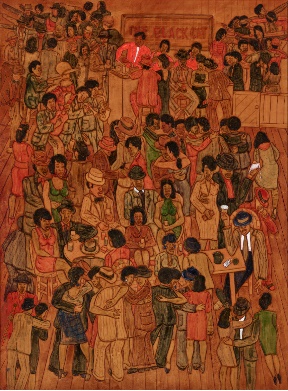 On Wednesday, January 18th, Christie’s New York held its Outsider & Vernacular art sale, featuring works by self-taught, naïve, and folk artists. I had previously written about how fourteen lots come from the collection of actress Jane Fonda. When the sale came, one of the works owned by Fonda made it to the top lots. But at the very top was not a painting or a sculpture but a piece of leatherwork. The specialists at Christie’s expected The Black Cat by Winfred Rembert to wind up as one of the more valuable lots, assigning it an estimate range of $150K to $200K. It is a 32½-by-24¼-inch piece of carved leather painted with dye, which was Rembert’s preferred medium. Rembert had been involved in the Civil Rights movement. Consequently, he got thrown in jail twice, and a mob nearly lynched him. He served seven years in prison, where he learned leatherworking. He married, moved from his native Georgia to Connecticut, and started creating original works at age 51 in 1986. Despite moving across the country, much of his works recall his younger years spent in the South, including The Black Cat, showing the interior of a dance hall. The carved leather dance hall scene exceeded its estimate range, selling for $240K (or $302.4K w/p). Just behind the Rembert was a small work of graphite on cardboard by Bill Traylor, who is becoming one of the biggest names in outsider art. Traylor had been born into slavery in 1853 and spent most of his life in Alabama. He created the drawing, entitled Goat, Camel, Lion and Figures, in 1939 when he was 86 years old. The picture previously sold at Christie’s New York on January 18, 2019 for a hammer price of $100K, leading experts to give it a $200K to $300K estimate range this time around. Goat, Camel, Lion and Figures hit its low estimate of $200K (or $252K w/p).
On Wednesday, January 18th, Christie’s New York held its Outsider & Vernacular art sale, featuring works by self-taught, naïve, and folk artists. I had previously written about how fourteen lots come from the collection of actress Jane Fonda. When the sale came, one of the works owned by Fonda made it to the top lots. But at the very top was not a painting or a sculpture but a piece of leatherwork. The specialists at Christie’s expected The Black Cat by Winfred Rembert to wind up as one of the more valuable lots, assigning it an estimate range of $150K to $200K. It is a 32½-by-24¼-inch piece of carved leather painted with dye, which was Rembert’s preferred medium. Rembert had been involved in the Civil Rights movement. Consequently, he got thrown in jail twice, and a mob nearly lynched him. He served seven years in prison, where he learned leatherworking. He married, moved from his native Georgia to Connecticut, and started creating original works at age 51 in 1986. Despite moving across the country, much of his works recall his younger years spent in the South, including The Black Cat, showing the interior of a dance hall. The carved leather dance hall scene exceeded its estimate range, selling for $240K (or $302.4K w/p). Just behind the Rembert was a small work of graphite on cardboard by Bill Traylor, who is becoming one of the biggest names in outsider art. Traylor had been born into slavery in 1853 and spent most of his life in Alabama. He created the drawing, entitled Goat, Camel, Lion and Figures, in 1939 when he was 86 years old. The picture previously sold at Christie’s New York on January 18, 2019 for a hammer price of $100K, leading experts to give it a $200K to $300K estimate range this time around. Goat, Camel, Lion and Figures hit its low estimate of $200K (or $252K w/p).
Two works tied for third place on Wednesday, one of which was a work by Thornton Dial from Jane Fonda’s collection. Untitled from 1991 consisted of mixed media on a large 76-by-65-inch canvas, which includes paint, fabric, wire, and epoxy. Sharing the third-place spot was Henry Darger’s Eagle Headed Blengin, a work of graphite, carbon transfer, and watercolor on paper from the collection of Siri von Reis. I found this work most interesting because much of Darger’s work includes subjects from his own fantasy world he developed for an unpublished book called The Story of the Vivian Girls. The subject of this particular piece is a winged creature with a serpent’s tail and an eagle’s head. This subject appears in several works, referring to them as Blengiglomenean Serpents. In his mythology, they act as protectors of his stories’ characters. Both the Dial and Darger works had estimates of $50K to $100K, and ended up with a final hammer price of $85K (or $107.1K w/p).
While a small handful of works more than doubled their original high estimates, only one realized more than triple. Voice of the Third Angel by Minnie Evans consists of oil paint and ink on paperboard. Not only do we know the year of its creation, but its exact date, with Evans inscribing “November 22, 1963” on the reverse. Whether or not the work has any connection with the assassination of President John F. Kennedy, which occurred on that date, is unknown. Specialists only predicted it to sell for no more than $10K, but it ended up selling for nearly three-and-a-half times that at $34K (or $42.8K w/p).
Forty-two of the one-hundred-three available lots (41%) sold within their estimate ranges. Additionally, twenty-seven lots (26%) sold above, while thirty-three (32%) sold below. Only a single lot was bought in, giving Christie’s a sell-through rate of 99%. The entire sale was predicted to bring in anywhere between $1.24M and $2.04M, so Christie’s must be rather pleased by the $1.64M total hammer.
Queen Victoria’s Paintings Up For Grabs
 This weekend, the London auction house Hansons will be hosting their Fine Art, Antiques and Collectors auction. It’s all a bit of a hodgepodge consisting of 442 lots of various artworks, including Indian bronzes, Chinese porcelain, collections of jewelry, silver, and coins, as well as several paintings and prints. While the most highly valued lots include an early 17th-century portrait of a Dutch child (est. £18K to £20K), as well as a large silver bowl in the shape of a life-size swan (est. £35K to £45K), some critics and journalists have their eye on this sale for something entirely different. Two decent-looking floral still-lifes will be up for sale that day as well, and the house specialists estimate them to sell for between £8K and £10K each. No one is sure of the year of their creation, but they are almost certainly the work of a 19th-century British woman. We know this because, according to their previous owner, they are original works by none other than Queen Victoria.
This weekend, the London auction house Hansons will be hosting their Fine Art, Antiques and Collectors auction. It’s all a bit of a hodgepodge consisting of 442 lots of various artworks, including Indian bronzes, Chinese porcelain, collections of jewelry, silver, and coins, as well as several paintings and prints. While the most highly valued lots include an early 17th-century portrait of a Dutch child (est. £18K to £20K), as well as a large silver bowl in the shape of a life-size swan (est. £35K to £45K), some critics and journalists have their eye on this sale for something entirely different. Two decent-looking floral still-lifes will be up for sale that day as well, and the house specialists estimate them to sell for between £8K and £10K each. No one is sure of the year of their creation, but they are almost certainly the work of a 19th-century British woman. We know this because, according to their previous owner, they are original works by none other than Queen Victoria.
While many may be aware of King Charles III’s love of painting, most people are probably unaware of his great-great-great-grandmother’s artistic dabblings. Both still-lifes, one of azaleas, the other of flag irises, are from the collection at Carisbrooke Castle on the Isle of Wight. The castle had been the home of Queen Victoria’s daughter Princess Beatrice until she died in 1944. The year after her death, Beatrice’s son Alexander began to sell parts of the art collections kept at the royal properties on the Isle of Wight, including Osborne House and Carisbrooke Castle. This was where the current owner of the queen’s paintings claimed her grandfather had purchased them. The paintings also come with a letter from Alexander positively attributing the works to the queen. Paintings positively attributed to Queen Victoria are incredibly rare, with only 15 works of hers ever sold at auction. Her auction record was set at Christie’s London in 2015 when a bust portrait of a young maid sold for £24K hammer.
____________________
Deeper Thoughts
By: Nathan
The Louvre's Limit On Visitors
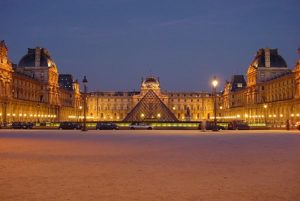 In 2022, the Louvre was the most visited museum in the world. While attendance numbers are still not quite reaching pre-pandemic levels, the museum has made vast improvements since 2021. However, the museum administration recently admitted to voluntarily restricting attendance, not for safety’s sake, but to give museum visitors a more pleasant experience. Having been to the Louvre myself, I know the number of people trying to gain entrance can be dizzying. Visitors can wait for hours even if they're just there for the Mona Lisa. Consequently, the gallery housing the Mona Lisa can feel less like a museum and more like a mosh pit. But not only will the visitor cap reduce congestion in the galleries, but it will improve the livelihood of the museum’s 2,000 employees. In the past, Louvre staff have gone on strike over the deteriorating conditions due to the crowds. In response, on top of the visitor cap, the new museum director, Laurence des Cars, has also announced a two-year renovation project to improve these conditions for visitors and employees. In the meantime, the Louvre will host no new shows or exhibitions.
In 2022, the Louvre was the most visited museum in the world. While attendance numbers are still not quite reaching pre-pandemic levels, the museum has made vast improvements since 2021. However, the museum administration recently admitted to voluntarily restricting attendance, not for safety’s sake, but to give museum visitors a more pleasant experience. Having been to the Louvre myself, I know the number of people trying to gain entrance can be dizzying. Visitors can wait for hours even if they're just there for the Mona Lisa. Consequently, the gallery housing the Mona Lisa can feel less like a museum and more like a mosh pit. But not only will the visitor cap reduce congestion in the galleries, but it will improve the livelihood of the museum’s 2,000 employees. In the past, Louvre staff have gone on strike over the deteriorating conditions due to the crowds. In response, on top of the visitor cap, the new museum director, Laurence des Cars, has also announced a two-year renovation project to improve these conditions for visitors and employees. In the meantime, the Louvre will host no new shows or exhibitions.
Due to the crowds and the conditions, in June 2022 the museum administration decided to place a cap of 30,000 on daily attendance. However, the museum only told the press about this policy last week. The Louvre is only closed on Tuesdays as well as three holidays per year, meaning that if the Louvre met its daily maximum every day, museum attendance would reach 9.3 million people. In 2022, the Louvre welcomed 7.8 million visitors, while the second-place Musée d’Orsay only saw 3.2 million. So it would still be the most-visited museum in the world even with the visitor cap. This may be a bit of a risky move since it may disappoint or even aggravate some tourists. Imagine waiting in line for hours only to be told that, unfortunately, you’re the 30,001st person. But perhaps simply seeing a line a little too long may deter some people from joining in, knowing there’s a cap on visitors. In any case, if you manage to get in, at least you won’t have to wade through a horde of people with selfie sticks (if those are still a thing) just to see the smaller-than-expected Mona Lisa.
Art History Professor's Firing Gets Attention
 Last week, the news cycle blew up a story coming out of a small university in Saint Paul, Minnesota, where an adjunct art history professor was, in effect, fired over an image she presented in her classroom. And while the incident itself has received much attention from journalists, commentators, and politicians, the reaction and backlash in the wake of the incident are far more important. Erika López Prater taught a global art history class at Hamline University. One day, in her class, her presentation and lecture featured a 14th-century image of the Prophet Muhammad. If you’re unfamiliar, according to Islamic law, producing or displaying an image of the prophet is strictly forbidden, as it is considered sacrilegious. Because of this, a Muslim student complained to the school’s administration; consequently, they have not renewed López Prater’s contract.
Last week, the news cycle blew up a story coming out of a small university in Saint Paul, Minnesota, where an adjunct art history professor was, in effect, fired over an image she presented in her classroom. And while the incident itself has received much attention from journalists, commentators, and politicians, the reaction and backlash in the wake of the incident are far more important. Erika López Prater taught a global art history class at Hamline University. One day, in her class, her presentation and lecture featured a 14th-century image of the Prophet Muhammad. If you’re unfamiliar, according to Islamic law, producing or displaying an image of the prophet is strictly forbidden, as it is considered sacrilegious. Because of this, a Muslim student complained to the school’s administration; consequently, they have not renewed López Prater’s contract.
Many news sites have latched onto this story, claiming that sensitive young people and religious zealots stifle free speech on our college campuses and that this is only the most recent incident. However, while I disagree with the actions taken by the university administration, I voice my opposition in a very different way, coming from a very different place than those commentators, who also complain that Islamophobia is not a serious issue, while cancel culture is. If you look at the facts of the case, you’ll see that many of the actors involved made terrible decisions for seemingly the right reasons.
In López Prater’s class, the syllabus warned students that the lecture would include images of the Prophet Muhammad and that they would be allowed to leave the room to make them more comfortable. The professor also announced this at the beginning of the class. Furthermore, some images of Muhammad are, by nature, disrespectful, like the case of the 2005 Muhammad cartoons controversy in Denmark. But the image shown in the classroom was made by Muslims, for Muslims, during a time when it was acceptable to create images of the prophet. The work is an illustration from a historical chronicle commissioned by Ghazan, who ruled over a good chunk of western Asia, including much of modern Iran, Iraq, Syria, Turkey, Afghanistan, and Pakistan. Despite the professor’s warnings, the nature of the image, and the academic setting, a student complained to the school’s administration anyway. The university, consequently, accused the professor of Islamophobia and announced that they would not renew her contract. Had the incident been properly investigated before the university took action, the school would’ve realized that they may have jumped the gun a little bit.
While Hamline University’s administration does bear some guilt, it’s easy to see that many of the people involved were well-intentioned and only trying to do the right thing. Islamophobia is a serious problem in the United States and the West in general. Therefore accusations of Islamophobia should be taken seriously. This also applies to any allegation of hatred or discrimination against a marginalized group. However, connecting Erika López Prater’s firing with Islamophobia belittles and delegitimizes the very real acts of hatred and discrimination levied against minority groups today. Of course, trying to do the right thing is always good. But sometimes, being too quick in doing so can backfire and hurt everyone.
Art Institute Of Chicago's Payroll Plunder
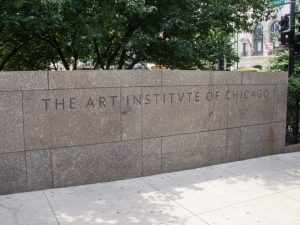 Recently, federal prosecutors charged the Art Institute of Chicago’s former payroll manager for allegedly stealing about $2.3 million from the museum over 13 years. 56-year-old Michael Maurello is accused of stealing this money between 2007 and 2020. He made deposits to his bank account and then falsified the museum’s financial records to make it look like other employees were the recipients. He then labeled these payments as money for paid time off or tuition reimbursement. Maurello’s coworkers became aware of his activities in early 2020. When confronted about his most recent payment, he lied, saying it was just a test of the payroll system. The museum subsequently fired him and alerted the authorities. According to the museum, the amount stolen was significant. But because it was siphoned off gradually for more than a decade, “it did not impact decisions around staffing, payroll, scholarship funding, programming, or other financial aspects of the organization”.
Recently, federal prosecutors charged the Art Institute of Chicago’s former payroll manager for allegedly stealing about $2.3 million from the museum over 13 years. 56-year-old Michael Maurello is accused of stealing this money between 2007 and 2020. He made deposits to his bank account and then falsified the museum’s financial records to make it look like other employees were the recipients. He then labeled these payments as money for paid time off or tuition reimbursement. Maurello’s coworkers became aware of his activities in early 2020. When confronted about his most recent payment, he lied, saying it was just a test of the payroll system. The museum subsequently fired him and alerted the authorities. According to the museum, the amount stolen was significant. But because it was siphoned off gradually for more than a decade, “it did not impact decisions around staffing, payroll, scholarship funding, programming, or other financial aspects of the organization”.
Maurello is currently being charged in federal court with two counts of wire fraud and two counts of bank fraud. A federal wire fraud conviction carries a maximum prison sentence of 20 years, while a federal bank fraud conviction carries a maximum of 30 years. Therefore Maurello is hypothetically facing 100 years in federal prison. His arraignment has yet to be scheduled. Maurello will be forced to return any of the stolen funds he still has, as well as anything he purchased using the museum’s money. The museum is hoping to recover the remaining money through insurance, while they have also put several new policies in place to detect and prevent any future theft.
Glass Onion: A Critique Of Collectors [Spoiler Alert]

In late December, many people I know decided to watch the mystery movie Glass Onion on Netflix. It is a sequel to the movie Knives Out, with Daniel Craig reprising his role as Southern gentleman detective Benoit Blanc. The film features commentary on success, wealth, and influence, mainly through the character of eccentric tech billionaire Miles Bron, played by Edward Norton. Bron has filled his residence on his private island in Greece with countless treasures purchased with his fortune. Kathryn Hahn’s character describes the home’s interior as akin to the Tate Modern. Eagle-eyed viewers would notice works in the style of Francis Bacon and Cy Twombly on the walls, likely created by the film’s art department to populate a fictional billionaire’s art collection. But there are also recreations of real paintings in the background of many shots, including Picasso’s Cat Devouring a Bird and Nichols Canyon by David Hockney. Also featured are glass or crystal replicas of famous sculptures like Jeff Koons’s Balloon Dog and Bird in Space by Constantin Brâncuşi.
By the end, the film becomes a critique of wealthy, seemingly successful people who, in reality, owe their success mainly to profiting off the ideas of others. Many claim that figures like Elon Musk or Jeff Bezos may have inspired Norton’s character. Miles Bron is revealed to be an idiot passing himself off as a genius. While this isn’t revealed until far into the film, there are some warning signs to pick up on, including his art collection. The works on the walls appear to be scattered about in a random assortment. There doesn’t seem to be any effort to display these works properly alongside works in the same style, or by the same artist, or even hanging them in proper lighting. This may indicate that their owner purchased them not for their aesthetic qualities or admiration for twentieth-century abstract art but rather for their estimated value. This reflects some real-world collectors, some of whom often primarily see valuable art more as an investment to be profited from rather than a person’s original creation to be admired.
Keeping a horde of well-known paintings in a mansion on a private island may also be a criticism of some collectors’ practices of keeping art away from public view. The most notable example of this is Da Vinci’s Salvator Mundi, the most expensive painting yet sold at auction. While it is not confirmed, the work is reportedly stored not in a properly-curated museum or gallery space but on Saudi Crown Prince Mohammed bin Salman’s private yacht. The most glaring example of Glass Onion’s critique of amateur collectors is one painting in Miles Bron’s art collection. Mark Rothko’s Number 207 (Red over Dark Blue on Dark Gray) hangs in the background of several scenes. But anyone who knows the painting will realize that the work is actually hung upside down. Rian Johnson later admitted that he intentionally did this to indicate how little Miles knows or cares about his collection and to reveal the character’s true nature. Johnson wanted to convey “a lack of self-awareness”. In any case, Glass Onion is a film that is not necessarily about art but uses art very smartly to send a message about its characters and the world.
The Rehs Family
© Rehs Galleries, Inc., New York – February 2023



